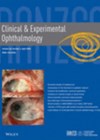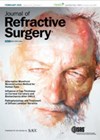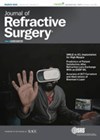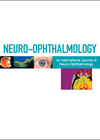
Journal Reviews archive for August 2020
Accuracy of intraocular lens power calculations in paediatric eyes
A study comparing the accuracy of the SRK II, SRK/T, Hoffer Q, Holladay 1, T2 and Super formula in predictive refractive outcomes in children undergoing primary IOL insertion into the capsular bag following cataract surgery. A total of 377 eyes...
Diffuse lamellar keratitis
This study group reviewed cytokine- and chemokine-mediated mechanisms of diffuse lamellar keratitis (DLK) after lamellar corneal surgical procedures. DLK can occur early or late (months to decades) after all lamellar corneal surgeries, including laser in situ keratomileusis, small incision lenticule...
Patient satisfaction after refractive lens exchange with an EDOF lens
The aim of this study was to identify independent factors associated with postoperative satisfaction after refractive lens exchange with an extended depth of focus intraocular lens (EDOF IOL). Patients who underwent a refractive lens exchange with bilateral implantation of the...
Practical application of cataract risk stratification
This study assessed the practicability of a risk stratification system, the New Zealand Cataract Risk Stratification (NZCRS) in a major teaching hospital. The scoring system was as follows: three points for Dense cataract, pseudoexfoliation (PXF), phacodonesis, previous vitrectomy and only...
Risk factors for lens dislocation post cataract surgery
This retrospective cohort study in Korea assessed the risk factors for intraocular lens (IOL) dislocation. They used national data of 2,162,191 patients who had had cataract surgery between 2009 and 2016. They excluded any patient who had an IOL dislocation...
Visual field progression after glaucoma drainage device implantation
This retrospective interventional case series assessed changes to visual fields after implantation of a glaucoma drainage device (Baerveldt, Ahmed or Molteno Devices) between 2010 and 2015. A total of 106 eyes from 96 patients were included in the final analysis...
Investigating MOG-IgG as a cause for optic perineuritis
Optic perineuritis can be a manifestation of infectious and systemic inflammatory disorders, but in most cases is considered idiopathic. Diagnosis is established by magnetic resonance imaging (MRI) with the demonstration of optic nerve sheath enhancement with sparing of the optic...
Examination of optic disc drusen using computer-based fundus analysis
This case-control study analysed the optic disc angioarchitecture in optic disc drusen (ODD) using computer-based fundus examination. A group of ODD patients were compared to a group of healthy controls with normal optic discs. The cohort included 30 healthy volunteers...
A novel presentation of optic disc oedema with syphilis
Optic disc oedema (ODE) due to syphilis without visual compromise has been primarily attributed to papilloedema from raised intracranial pressure or optic perineuritis from optic nerve sheath inflammation. These terms were proposed before magnetic resonance imaging (MRI) was largely available....
Mechanism of colour vision involvement in multiple sclerosis
There is evidence to show that the optic nerve and retina are affected in multiple sclerosis (MS) even without any clinical evidence or history of optic neuritis (ON). MS without optic neuritis causes colour-vision deficit, however, the evidence for selective...
Using small amplitude saccades to assess saccadic velocity
Saccades are a key component in the assessment and diagnosis of neuro-ophthalmological disorders. Clinicians are typically taught to use large amplitude saccades (LAS) of at least 20 degrees to assess saccadic velocity. It has been suggested, however, that small amplitude...
Saccadic eye movements in young-onset Parkinson’s disease
The objective of this study was to understand control of saccadic eye movements in patients with young onset Parkinson’s disease (YOPD) where onset of disease symptoms appears early in life (<40 years of age). Functional magnetic resonance imaging (fMRI) was...









